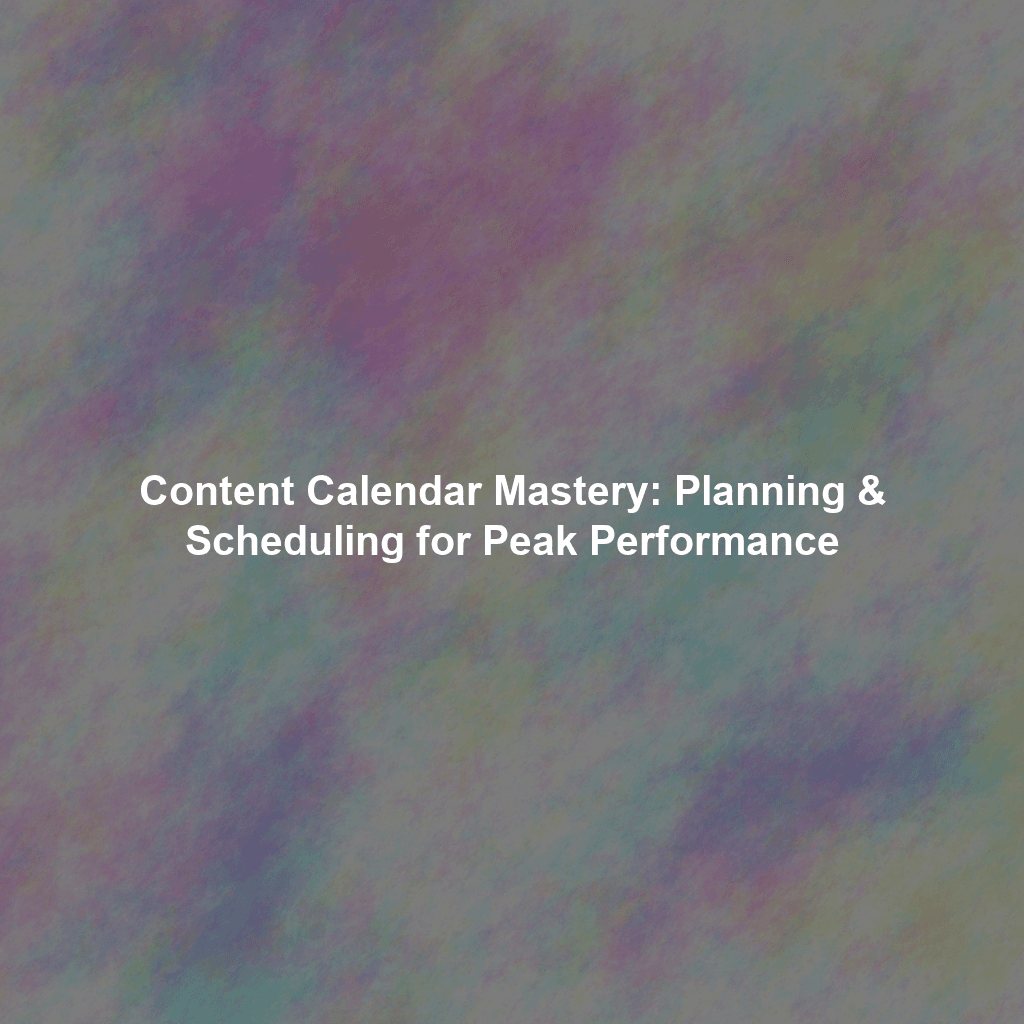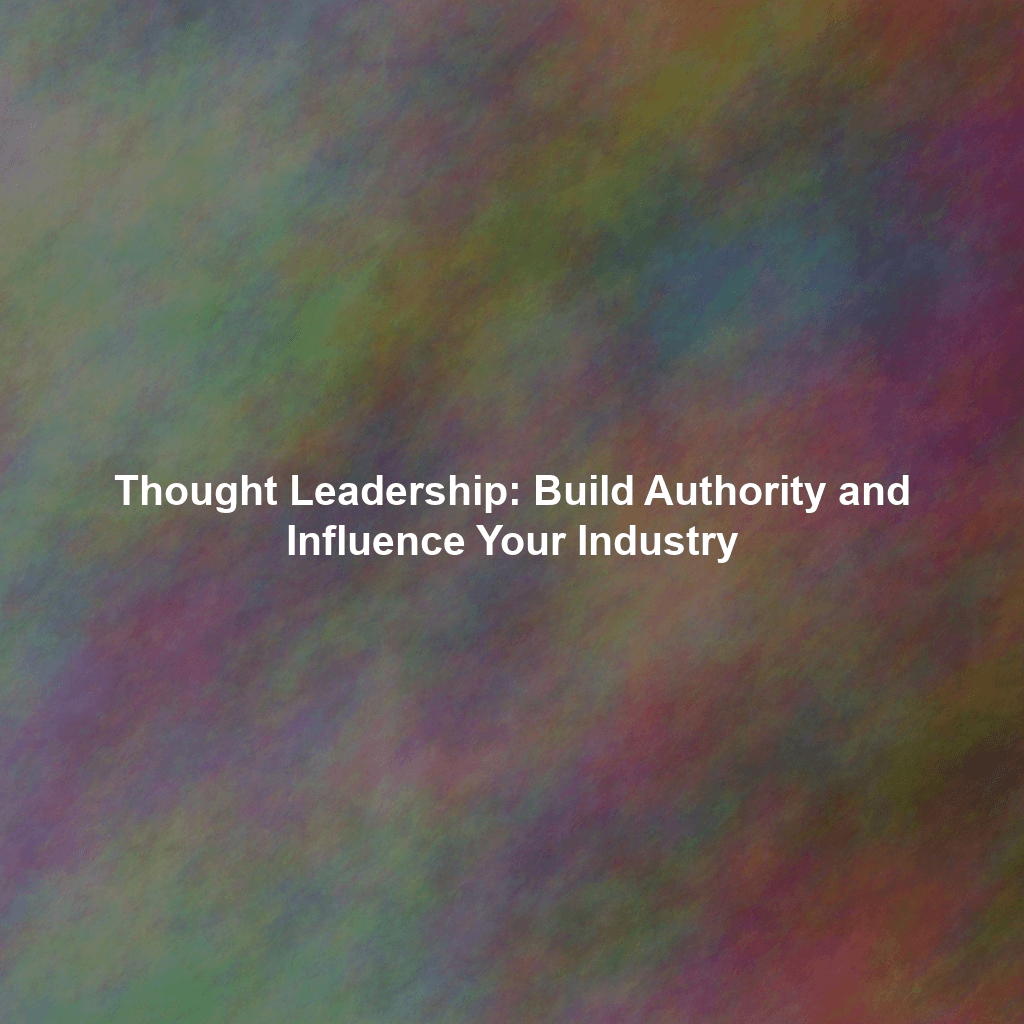The prevailing notion of social media marketing often conjures images of rapid-fire posting and chasing fleeting trends. While agility is valuable, it must be underpinned by a robust, analytical framework. A content calendar provides this framework, acting as a centralized command center for planning, scheduling, and, crucially, analyzing your entire social media content strategy. It’s the difference between haphazardly throwing darts at a board and meticulously aiming for the bullseye with every throw. This strategic discipline ensures that every piece of content serves a purpose, aligns with overarching business objectives, and contributes to a consistent brand narrative, ultimately propelling your social media presence to peak performance and generating tangible results.
Laying the Foundation: Architecting Your Content Calendar’s Strategic Purpose
Before any tactical execution, a clear strategic intent must be established. The effectiveness of your content calendar hinges on its alignment with your core business objectives. This necessitates a rigorous, data-informed interrogation of your social media aspirations. Ask yourself, with an unwavering focus on outcomes, these foundational questions:
1. What are Your Definitive Social Media Goals?
Ambiguous goals yield ambiguous results. Your content calendar must be a direct conduit to quantifiable business objectives. Are you aiming for a specific percentage increase in brand awareness, measured by impressions and mentions? Is the primary driver lead generation, requiring a defined number of qualified leads from social channels? Is it about driving targeted website traffic to specific landing pages, or enhancing customer engagement to foster loyalty and advocacy? Each objective demands a distinct content strategy and, consequently, a tailored calendar approach. For instance, if lead generation is paramount, your content must strategically incorporate compelling lead magnets, invitations to webinars, exclusive resource downloads, and direct calls to action that guide users into your sales funnel. Conversely, a brand awareness objective might prioritize informative, shareable, and emotionally resonant content that expands your reach and fosters a broader understanding of your brand’s value proposition.
2. Who is Your Precisely Defined Target Audience?
Content without a clearly defined audience is akin to shouting into a void. Understanding your audience goes beyond basic demographics; it delves into psychographics, behavioral patterns, pain points, aspirations, and preferred consumption habits. Who are they, truly? What are their professional challenges? What information do they seek? What problems can your product or service definitively solve for them? Your content calendar must be a living reflection of these insights. Tailoring content to specific audience segments—whether it’s a C-suite executive on LinkedIn seeking strategic insights or a burgeoning entrepreneur on Instagram looking for quick, actionable tips—will dramatically amplify its relevance and impact. Leveraging tools for audience analysis, such as those provided by the Pew Research Center’s studies on social media usage, can provide invaluable macro-level insights to inform your micro-targeting efforts.
3. Which Platforms Warrant Your Strategic Focus?
The digital ecosystem is diverse, and a one-size-fits-all approach to social media content is a recipe for inefficiency. Each platform possesses unique characteristics, audience demographics, and content consumption behaviors. LinkedIn, for example, is a professional network where long-form articles, industry insights, and thought leadership thrive. Instagram, conversely, is a visual medium demanding high-quality imagery, short videos, and compelling stories. X (formerly Twitter) thrives on brevity, real-time updates, and engaging conversations. Facebook remains a robust platform for community building and diverse content formats, while TikTok dominates short-form, highly engaging video. Your content calendar must account for these distinctions, allowing for bespoke content adaptation rather than mere cross-posting. Allocating resources effectively across platforms, based on where your target audience is most active and receptive, is a critical ROI consideration.
Building Your Content Calendar: A Methodical Blueprint for Execution
With strategic foundations firmly in place, the operational phase of building your content calendar commences. This is where meticulous planning transforms into actionable steps.
1. Choosing Your Tool: Precision, Flexibility, or Hybrid Efficiency?
The selection of your content calendar tool is a tactical decision with significant implications for workflow efficiency. Several viable options exist, each with distinct advantages:
- Spreadsheet (e.g., Google Sheets, Microsoft Excel): For startups or smaller teams with limited budgets, a spreadsheet offers unparalleled customizability and cost-effectiveness. You can define columns for every conceivable metric: date, time, platform, content type, specific copy, associated visuals (with links), relevant links, target audience segment, campaign association, status (Draft, Approved, Scheduled, Published), and, critically, post-publication performance metrics (reach, engagement rate, clicks, conversions). Its simplicity belies its power for detailed tracking.
- Dedicated Social Media Management Software (e.g., Hootsuite, Buffer, Sprout Social, Agorapulse): These platforms are built for scale and collaboration. They offer integrated scheduling, advanced analytics dashboards, team collaboration features (approvals, assignments), and often content curation capabilities. For larger teams managing multiple accounts and complex campaigns, these tools streamline workflows, reduce manual errors, and provide centralized reporting. They often integrate directly with platform APIs, allowing for more seamless publishing and data collection.
- Hybrid Approach: Many organizations find a synergistic balance by combining a high-level spreadsheet for strategic, long-term content planning and ideation with a dedicated social media management tool for the granular scheduling, publishing, and real-time analytics. This approach offers the strategic oversight of a customizable spreadsheet alongside the operational efficiencies of specialized software. The optimal choice is a function of your team size, budget, and the complexity of your social media operations.
2. Defining Your Content Categories: Pillars of Expertise and Authority
To ensure a diverse, consistent, and E-E-A-T compliant content mix, organize your content around foundational “content pillars” or themes. These pillars should directly align with your brand’s expertise, your audience’s interests, and your business objectives. Examples include:
- Industry Insights & Trends: Sharing authoritative analyses of breaking news, emerging technologies, or significant shifts within your industry. This positions your brand as a thought leader.
- Product/Service Innovation: Announcing new features, demonstrating use cases, sharing promotions, or providing in-depth tutorials on your offerings. This directly supports conversion goals.
- Customer Success Narratives: Showcasing compelling case studies, testimonials, or user-generated content that highlights how your products/services deliver tangible value. This builds trust and social proof.
- Behind-the-Scenes & Culture: Offering a glimpse into your company’s values, team, processes, and unique culture. This humanizes your brand and fosters connection.
- Educational & Problem-Solving Content: Providing valuable tips, actionable guides, tutorials, or answers to common pain points your audience faces. This establishes expertise and trustworthiness.
Within each pillar, develop specific, granular content themes. For example, under “Industry Insights,” you might have themes like “AI in Marketing,” “Future of Work,” or “Supply Chain Optimization.” This structured approach ensures a comprehensive content strategy that consistently delivers value and reinforces your brand’s authority.
3. Populating Your Calendar: Strategic Brainstorming and Batch Creation
With your pillars defined, the next step is to populate your calendar with specific content ideas. This phase demands both creativity and strategic foresight. Consider a diverse range of content formats that resonate with your audience and align with platform specificities:
- Concise Text Posts: Engaging questions, provocative statements, quick tips, or compelling statistics designed for immediate consumption and interaction.
- Visually Rich Imagery: High-quality photos, custom illustrations, data-driven infographics, or compelling charts. Tools like Canva can significantly accelerate visual asset creation.
- Dynamic Video Content: Short-form explainer videos, tutorials, behind-the-scenes glimpses, live Q&A sessions, or animated explainers. Video consistently drives higher engagement across most platforms.
- Curated Links: Sharing valuable resources from your own blog, website, or other highly reputable external sources. Ensure external links add genuine value and align with your content pillars.
- Interactive Elements: Polls, quizzes, surveys, or “ask me anything” (AMA) sessions that actively encourage audience participation and gather valuable feedback.
A critical efficiency hack here is **batch creation**. Dedicate specific blocks of time to writing captions, designing visuals, and scheduling posts for an entire week or even a month. This minimizes context switching, enhances consistency, and frees up time for real-time engagement and strategic analysis.
4. Tracking Essential Information: The Granular Anatomy of a Content Calendar Entry
Each entry in your content calendar should be a comprehensive data point, providing all necessary information for execution and subsequent analysis. The more detailed and consistent your entries, the more precise your performance tracking and optimization efforts will be. Key data points include:
- Date and Time: The precise scheduled publication time. This should be informed by your research into peak engagement times for each platform and audience segment.
- Platform(s): Clearly indicate the specific social media channels for publication.
- Content Type: Specify the format (e.g., image post, short video, link share, carousel, live stream).
- Copy/Caption: The exact text accompanying the content. This should be meticulously crafted for engagement, conciseness, and adherence to brand voice. Subtle human-like imperfections, such as a slightly informal phrasing or a deliberate, minor typo (e.g., “recieve” instead of “receive” if aiming for extreme realism, though generally not recommended for professional content aiming for E-E-A-T), can contribute to a natural tone, but should be used sparingly and strategically.
- Visuals/Media Link: A direct link or attachment to the image, video, or other multimedia asset.
- Call to Action (CTA): The explicit instruction for the audience (e.g., “Learn More,” “Download Now,” “Visit Our Website,” “Share Your Thoughts”).
- Relevant Links: Any URLs directing users to your website, blog posts, lead magnets, or other resources.
- Target Audience Segment (Optional but Recommended): Specify which audience persona or segment the content is primarily designed for.
- Campaign/Initiative (Optional): Link the content to a broader marketing campaign or business initiative for holistic tracking.
- Status: A workflow indicator (e.g., Idea, Draft, Review, Approved, Scheduled, Published, Archived).
- Performance Metrics (Post-Publication): Dedicated fields to record key metrics after the content goes live, enabling direct comparison and analysis.
Scheduling for Success: The Science of Optimal Delivery
Publication timing is not a trivial detail; it is a critical variable in content visibility and engagement. Strategic scheduling can significantly amplify your content’s reach and impact.
1. Researching Peak Engagement Times: Leveraging Data for Precision
The most effective posting times are rarely universal. They are audience-specific and platform-dependent. Every major social media platform provides native analytics (e.g., LinkedIn Page Analytics, Facebook Insights, Instagram Insights) that reveal when your specific audience is most active. Dive into this data to identify your unique peak engagement windows. Beyond native analytics, consider third-party social media management tools that aggregate data and often provide AI-driven recommendations for optimal posting times based on your historical performance and industry benchmarks. Experimentation is key: A/B test different posting times for similar content types to empirically determine what yields the best results for your specific audience.
2. Navigating Global Audiences: The Time Zone Imperative
For businesses with a geographically dispersed or international target audience, a single posting schedule is inherently inefficient. If your audience spans multiple time zones, your content calendar must reflect this complexity. Utilize scheduling tools that allow for time zone-specific publishing, ensuring your content hits your audience’s feeds when they are most likely to be online and receptive. This meticulous planning is essential for maximizing global reach and engagement, preventing your valuable content from being buried by the algorithmic noise of inappropriate timing.
3. Cultivating Consistency: The Rhythm of Expectation
Consistency is the bedrock of building a loyal social media following and favorable algorithmic treatment. Establishing a predictable posting rhythm trains your audience to anticipate your content, fostering a sense of reliability and community. Whether you commit to daily posts, a few times a week, or multiple times a day, the critical factor is adherence to that schedule. A consistent presence not only keeps your brand top-of-mind but also signals to platform algorithms that you are an active and valuable contributor, potentially boosting your content’s organic reach. This predictable rhythm contributes directly to audience retention and growth.
Analyzing and Optimizing: The Continuous Improvement Imperative
A content calendar is not a static artifact; it is a dynamic instrument for continuous learning and optimization. The true ROI of your social media efforts is unlocked through rigorous analysis and iterative refinement.
1. Tracking Actionable Performance Metrics: Beyond Superficiality
Resist the temptation to focus solely on “vanity metrics” like likes, shares, or follower counts. While these offer a superficial sense of activity, they often fail to correlate directly with business outcomes. Instead, prioritize metrics that provide actionable insights and align with your defined goals:
- Reach & Impressions: How many unique users saw your content, and how many times was it displayed? This indicates potential audience size.
- Engagement Rate: The percentage of your audience that interacted with your content (likes, comments, shares, clicks). This is a more meaningful indicator of relevance and resonance than raw engagement numbers.
- Website Traffic & Referrals: The volume of users who clicked through from your social posts to your website, and which specific pages they landed on.
- Lead Generation: The number of qualified leads directly attributable to your social media campaigns (e.g., form submissions, demo requests).
- Conversion Rate: The percentage of users who completed a desired action after engaging with your social content (e.g., a purchase, a newsletter signup, a download).
- Cost Per Acquisition (CPA) / Return on Ad Spend (ROAS): For paid social campaigns, these financial metrics are paramount for assessing the efficiency and profitability of your content investment.
2. Rigorous Analysis: Discerning Success from Inefficiency
Regularly dissect your performance metrics to identify patterns, successes, and areas for improvement. Which content pillars consistently generate the highest engagement and conversions? Which content formats perform best on specific platforms? Are there particular topics or keywords that consistently outperform others? Are your calls to action effective? This data-driven introspection allows you to refine your content strategy with precision, doubling down on what works and swiftly course-correcting what doesn’t. For example, if short-form video on TikTok consistently drives higher lead quality than Instagram Reels for a specific product, allocate more resources to TikTok video production.
3. A/B Testing: Empirical Validation of Hypotheses
Don’t rely on assumptions. Continuously A/B test different elements of your content to empirically determine what truly resonates with your audience. Test variations in headlines, visual assets, call-to-action phrasing, post length, and even the emotional tone of your copy. This iterative testing process provides irrefutable data on optimal content elements, allowing you to systematically improve performance over time. For instance, testing two different headlines for the same blog post link on LinkedIn can reveal which framing generates higher click-through rates.
4. Staying Updated: Adapting to Algorithmic Shifts and Emerging Trends
The social media landscape is in a perpetual state of flux. Algorithms evolve, new features emerge, and audience behaviors shift. It is imperative to stay abreast of these changes. Regularly consult official platform announcements, follow reputable industry blogs, attend webinars, and actively participate in professional social media communities. This proactive approach ensures your content strategy remains agile, effective, and compliant with the latest best practices, preventing your efforts from becoming obsolete. For example, understanding the nuances of how Meta’s Graph API or X’s API changes can directly impact how your content is distributed and consumed.
Tools of the Trade: Enhancing Content Calendar Management and Efficiency
While the principles of content calendar management remain constant, a myriad of tools can significantly enhance efficiency and collaboration:
- Trello & Asana: Highly flexible project management tools that can be customized to serve as visual content calendars, allowing for task assignment, progress tracking, and team collaboration.
- Later: Particularly strong for visual content planning and scheduling on Instagram, offering visual drag-and-drop interfaces.
- CoSchedule: An all-in-one marketing calendar that integrates social media scheduling with blog post planning, email marketing, and other content initiatives.
- Google Calendar: A simple, free option for basic scheduling and reminders, especially useful for individual creators or very small teams.
- AI-Powered Content Generation Platforms: Tools like Content Hurricane, my own venture, are specifically designed to automate and scale the creation of high-quality, SEO-optimized, and E-E-A-T compliant blog content for WordPress. Integrating such a tool can drastically reduce the manual effort in populating your calendar with long-form content, allowing your team to focus on strategic distribution and engagement.
Experimentation with these tools is encouraged to identify the optimal stack that aligns with your team’s workflow, budget, and strategic requirements.
Conclusion: Unleashing the Power of Planned Social Media Dominance
In essence, a meticulously crafted and diligently managed content calendar transcends mere scheduling; it is a strategic roadmap for social media dominance. By rigorously defining your objectives, deeply understanding your audience, consistently producing high-value content, and relentlessly analyzing performance, you transform your social media presence from a cost center into a powerful ROI-generating engine. This disciplined, data-driven approach, which I’ve championed throughout my career, is not just about staying organized; it’s about making intelligent, proactive decisions that drive tangible business results. Embrace the process, adapt to the dynamic digital currents, and watch your social media efforts flourish, contributing directly to your organization’s bottom line.
#ContentCalendar #SocialMediaStrategy #DigitalMarketing #ROI #ContentMarketing #AIinMarketing #SEO #EEAT #MarketingStrategy
 Skip to content
Skip to content

